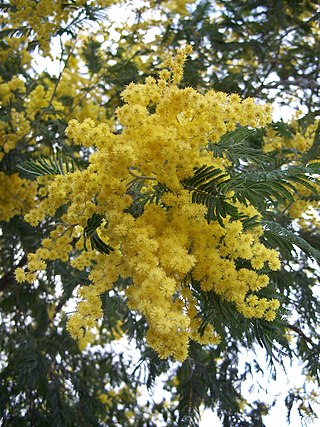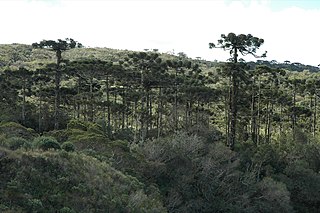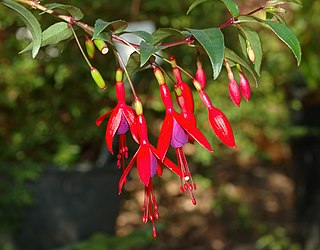
Mimosa is a genus of about 600 species of herbs and shrubs, in the mimosoid clade of the legume family Fabaceae. Species are native to the Americas, from North Dakota to northern Argentina, and to eastern Africa as well as the Indian subcontinent and Indochina. The generic name is derived from the Greek word μῖμος (mimos), an "actor" or "mime", and the feminine suffix -osa, "resembling", suggesting its 'sensitive leaves' which seem to 'mimic conscious life'.

Paraná is one of the 26 states of Brazil, in the south of the country. It is bordered in the north by São Paulo state, in the east by the Atlantic Ocean, in the south by Santa Catarina state and the province of Misiones, Argentina, and in the west by Mato Grosso do Sul and Paraguay, with the Paraná River as its western boundary. It is subdivided into 399 municipalities, and its capital is the city of Curitiba. Other major cities are Londrina, Maringá, Ponta Grossa, Cascavel, São José dos Pinhais and Foz do Iguaçu. The state is home to 5.4% of the Brazilian population and generates 6.2% of the Brazilian GDP.

Curitiba is the capital and largest city in the state of Paraná in Southern Brazil. The city's population was 1,963,726 as of 2021, making it the eighth most populous city in Brazil and the largest in Brazil's South Region. The Curitiba Metropolitan area comprises 29 municipalities with a total population of over 3,731,769, making it the ninth most populous metropolitan area in the country.

The Iguazu River, also called Rio Iguassu, is a river in Brazil and Argentina. It is an important tributary of the Paraná River. The Iguazu River is 1,320 kilometres (820 mi) long, with a drainage basin of 62,000 square kilometres (24,000 sq mi).

Chusquea is a genus of evergreen bamboos in the grass family. Most of them are native to mountain habitats in Latin America, from Mexico to southern Chile and Argentina.

Boa Esperança is a Brazilian municipality from the state of Minas Gerais. The municipality is located by the Serra da Boa Esperança, which became celebrated through song that brings its name, compounded by Lamartine Babo and performed by several singers. Across its territory passes Rio Grande, important to the development of the region. The economy of Boa Esperança is based on coffee plantations and tourism.

Mimosa tenuiflora, syn. Mimosa hostilis, also known as jurema preta, calumbi (Brazil), tepezcohuite (México), carbonal, cabrera, jurema, black jurema, and binho de jurema, is a perennial tree or shrub native to the northeastern region of Brazil and found as far north as southern Mexico, and the following countries: El Salvador, Honduras, Panama, Colombia and Venezuela. It is most often found in lower altitudes, but it can be found as high as 1,000 m (3,300 ft).

Mimosa pudica is a creeping annual or perennial flowering plant of the pea/legume family Fabaceae. It is often grown for its curiosity value: the sensitive compound leaves fold inward and droop when touched or shaken and re-open a few minutes later. It is well known for its rapid plant movement. Like a number of other plant species, it undergoes changes in leaf orientation termed "sleep" or nyctinastic movement. The foliage closes during darkness and reopens in light. This was first studied by French scientist Jean-Jacques d'Ortous. In the UK it has gained the Royal Horticultural Society's Award of Garden Merit.

Vachellia farnesiana, also known as Acacia farnesiana, and previously Mimosa farnesiana, commonly known as sweet acacia, huisache, or needle bush, is a species of shrub or small tree in the legume family, Fabaceae. Its flowers are used in the perfume industry.

Acacia dealbata, the silver wattle, blue wattle or mimosa, is a species of flowering plant in the legume family Fabaceae, native to southeastern Australia in New South Wales, Victoria, Tasmania, and the Australian Capital Territory, and widely introduced in Mediterranean, warm temperate, and highland tropical landscapes.

The Araucaria moist forests, officially classified as mixed ombrophilous forest in Brazil, are a montane subtropical moist forest ecoregion. The forest ecosystem is located in southern Brazil and northeastern Argentina. The ecoregion is a southern portion of the Atlantic Forest. The ecoregion also includes select areas of open field called "campos de cima da serra" or "coxilhas".

Albizia lebbeck is a species of plant in the family Fabaceae, native to the Indian subcontinent and Myanmar. It is widely cultivated and naturalised in other tropical and subtropical regions, including Australia. Common names in English include siris, Indian siris, East Indian walnut, Broome raintree, lebbeck, lebbek tree, frywood, koko and woman's tongue tree. The latter name is a play on the sound the seeds make as they rattle inside the pods. Siris is also a common name of the genus Albizia.
Mimosa invisa is a species of leguminous woody shrub or vine native to South America. Mimosa invisa includes two subspecies, each with two varieties: The species is considered to be noxious and invasive in much of the United States.

Chusquea culeou, the Chilean bamboo, is a species of flowering plant in the grass family Poaceae. An evergreen bamboo native to South America, unlike most species within the genus Chusquea, it is frost-tolerant and thus widely cultivated in temperate regions.

Mimosa scabrella is a tree in the family Fabaceae. It is very fast-growing and it can reach a height of 15 m (49 ft) tall in only 3 years. Its trunk is about 0.1–0.5 m (3.9–19.7 in) in diameter. It has yellow flowers.
Mimosa ophthalmocentra, or jurema-embira, is a tree in the family Fabaceae. It is native to Brazil. It is shrub or small tree about 3 to 5 m tall. Its blossoms come in long, narrow cylindrical spikes having yellowish white petals and a white stamen. The blossoms are sometimes found to have a pink tinge. The fruit is green, sometimes with red or purple, flat, about 8 cm long and about 1 cm wide.

Mimosa somnians, commonly known as dormideira, is a species of woody shrub in the genus Mimosa and the family Fabaceae. It is native to the Caribbean, Central America and South America. It is a short, low-lying shrub with minuscule thorns lining its stem-like hairs.
Argyrotaenia sphaleropa is a species of moth of the family Tortricidae. It is found in South America, where it has been recorded from Colombia, Bolivia, Brazil, Peru, Uruguay and Argentina.

Fuchsia regia is a plant species in the genus Fuchsia native to Brazil.















